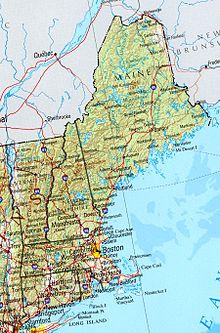New England
New England ( English New England [ nuːˈɪŋɡlənd ]) refers to an area in the northeast of the United States , which, along with Virginia, was the origin of English settlement in North America . The New England region includes the present-day states of Connecticut , New Hampshire , Maine , Massachusetts , Rhode Iceland and Vermont .
The Central Atlantic states join to the west.
First mention and description of New England
The name New England goes back to the mercenary and adventurer John Smith , who traveled and explored this area extensively around 1614. In 1616 he published a detailed description of this region in his book A Description of New England . He mentioned in particular the abundance of fish and wood in the area, which made later English settlers aware of this region.
colonization
The colonization of New England began in the 17th century through settlements near the coast. In 1620 the Pilgrim Fathers founded the settlement of Plymouth ( Plymouth Colony ). After 1629, as part of the Great Migration, tens of thousands of Puritans emigrated from England to the Massachusetts Bay Colony , founded that year, and established settlements such as Boston , Salem and Roxbury .
Further development of the region
During the 18th century, Boston developed into one of the most important ports in America. The unrest in connection with the so-called Boston Tea Party on December 16, 1773 is considered to be the trigger for the Revolutionary War , which led to the Declaration of Independence in 1776 . Therefore, Boston and New England are considered to be the birthplace of the United States.
The bourgeois, small-town character of this region caused its inhabitants to repeatedly stand in contrast to the southern states , which were characterized by plantation economy . New England was a major abolitionist stronghold in the 1860s . Yankee , originally a nickname for New Englanders, is still a dirty word in the southern states. Today, New England is considered liberal by US standards. In elections there, the Democratic Party usually wins , until around the Second World War , the then more liberal Republican Party was usually supported. The well-known universities of Yale , Harvard and MIT are located here .
Maine , the largest and northernmost of the New England states, is known for the beauty and unspoiled nature. In autumn there is a unique spectacle in the forests, the Indian Summer , when the leaves of the trees turn orange-red.
Biggest cities
- Boston , Massachusetts: 655.884
- Worcester , Massachusetts: 181.045
- Providence , Rhode Island: 178.042
- Springfield , Massachusetts: 153.060
- Bridgeport , Connecticut: 144.229
- New Haven , Connecticut: 129,779
- Hartford , Connecticut: 124.775
- Stamford , Connecticut: 122,643
- Waterbury , Connecticut: 110,366
- Manchester , New Hampshire: 109,565
- Lowell , Massachusetts: 106,519
- Cambridge , Massachusetts: 105.162
The largest cities of the two New England states not mentioned in this list are Burlington in Vermont with 42,500 inhabitants and Portland in Maine with 66,000 inhabitants.
See also
literature
- James B. Bell: Anglicans, Dissenters and Radical Change in Early New England, 1686-1786. Springer, Cham 2017, ISBN 978-3-319-55629-1 .
- Blake Harrison, Richard W. Judd (Eds.): A Landscape History of New England. MIT Press, Cambridge 2013, ISBN 978-0-262-52527-5 .
- Harry S. Stout: The New England Soul: Preaching and Religious Culture in Colonial New England. Oxford University Press, New York 2012, ISBN 978-0-19-989097-2 .
- Michael Hoberman: New Israel / New England: Jews and Puritans in Early America. University of Massachusetts Press, Boston 2012, ISBN 978-1-55849-920-1 .
- Bruce C. Daniels: New England Nation: The Country the Puritans Built. Palgrave Macmillan, Basingstoke 2012, ISBN 978-1-137-02562-3 .
- Joseph A. Conforti: Saints and Strangers: New England in British North America. Johns Hopkins University Press, Baltimore 2006, ISBN 978-0-8018-8254-8 .
- Stephen Foster: The Long Argument: English Puritanism and the Shaping of New England Culture, 1570-1700. 2nd, revised edition. University of North Carolina Press, Chapel Hill 1996, ISBN 978-0-8078-4583-7 .
Web links
- Literature about New England in the catalog of the German National Library
- New England Destination - New England Info from a Fan
Coordinates: 44 ° 12 ′ N , 70 ° 18 ′ W



